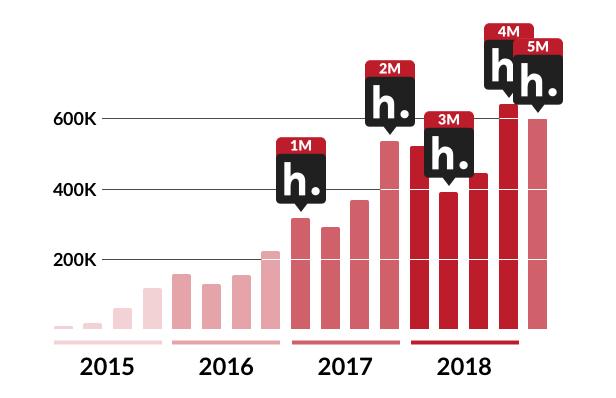5 Million Annotations
Hypothesis has reached a remarkable new milestone: five million annotations.
Just as we are about to mark the 30-year anniversary of the web’s invention at I Annotate 2019, and only two years after the W3C’s adoption of web annotation as a standard, this new record shows how annotation is realizing the original promise that Tim Berners-Lee sketched out in his 1989 document describing the World Wide Web.
Register now for I Annotate 2019, Wed 22–Thu 23 May at the American Geophysical Union’s newly refurbished “net zero” headquarters in Washington DC.
We continue to see strong growth in annotation, with each quarter setting new annotation records over the same quarter in the previous year. As you can see in the graph below, the pace of each new million annotations is accelerating. We also see similar growth in the number of new people annotating and active annotators in any period. In February, over 10,000 new users signed up to begin annotating, putting our total users at over 215,000.

The seasonal dip in new annotations in the spring and summer quarters shows a strong connection between annotation activity and the traditional academic schedule. Hypothesis is building on the growing use of annotation in teaching and learning with the release of our new LMS App.
Now educational institutions can integrate Hypothesis directly into their learning management system (LMS) to make it easier for students and teachers to annotate with single sign-on and automatic private groups for each class. In its first term of use this spring, over 400 classrooms are already using the new integration and institutions are starting to join our free pilot program.
Install the Hypothesis annotation app into your LMS and join our free pilot program.
Our partners
Hypothesis has also been adding new partnerships to spread annotation across the scholarly and publishing ecosystem, including publishers, scholarly societies, and other technology providers. Read more about how people are using annotation in all parts of the publishing workflow in each of our 42 partnerships shown below.
New capabilities
To support this growth, the Hypothesis product team has been releasing features to expand the possibilities for using annotation. One of our most powerful new capabilities is a richer groups model, which adds additional group configurations to our already existing private group option. As you can see in the table below, open and restricted groups now support use cases where annotations can be collected together with new options for who can view and add to each collection.
Our partners are already deploying these new groups, like the American Society of Plant Biologists, which is using an open group to add conversation and additional material like peer review reports, companion articles, and author biographies to its publications on the Highwire platform.
| Public Layer | Open Group | Restricted Group | Private Group | |
|---|---|---|---|---|
| Who can read annotations? | Anyone | Anyone | Anyone | Only logged-in group members |
| Who can post annotations? | Any logged-in user | Any logged-in user | Only logged-in group members | Only logged-in group members |
| Who can join? | N/A as anyone who is logged in to Hypothesis can annotate in the Public Layer | N/A as anyone who is logged in to Hypothesis can annotate in an Open Group | Invite only | Invite only: Group creator can share a link for users to join group |
Thank you
Everything at Hypothesis happens only thanks to the support we receive from our partners, funders, and community. Thank you for being a part of our first five million annotations!
We look forward to seeing you at one of the upcoming events our team will attend, including:
- Online Learning Consortium Innovate 2019 in Denver, CO (2–5 April)
- Fiesole Collection Development Retreat in Florence, Italy (3–5 April)
- UKSG’s 42nd Annual Conference and Exhibition in Telford, UK (8–10 April)
- 2019 Council of Science Editors Annual Meeting in Columbus, OH (4–7 May)
- Library Publishing Forum 2019 in Vancouver, BC (8–10 May)
- SSP 41st Annual Meeting in San Diego, CA (29–31 May)
- International Conference on Electronic Publishing 2019 (ElPub) in Marseilles, France (2–4 June)
- Association of University Presses Annual Meeting, Detroit, MI (11–13 June)
- and of course, I Annotate 2019 in Washington, DC (22–23 May)
